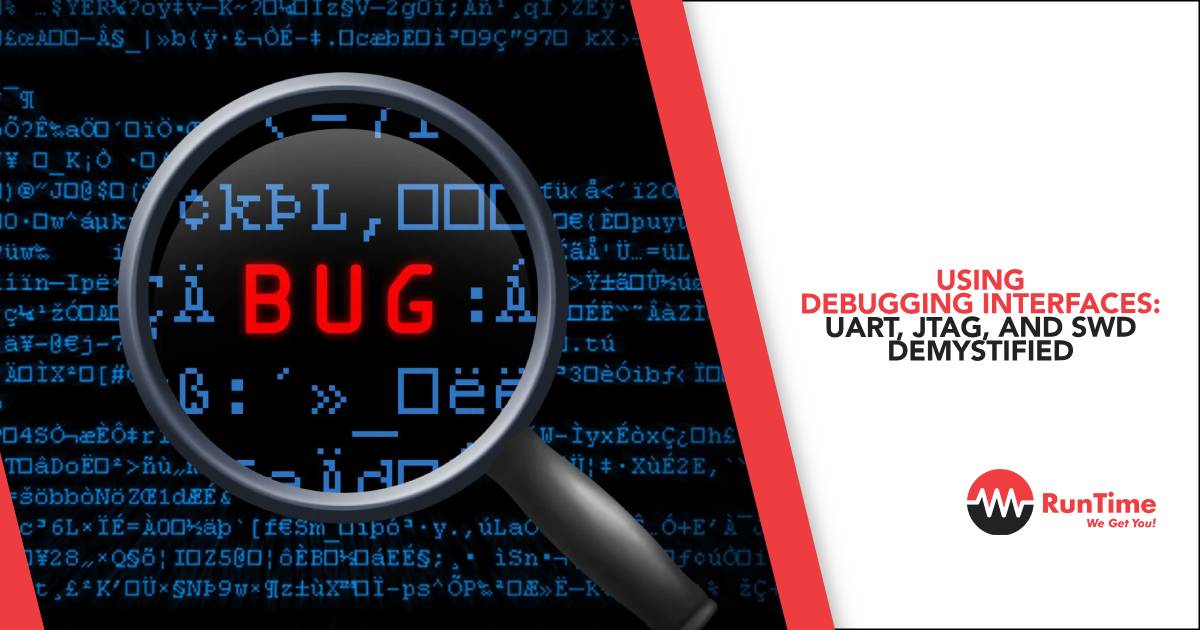Debugging is a cornerstone of embedded engineering, and debugging interfaces are the tools that make it possible. Whether you’re tracking down intermittent bugs, verifying system behavior, or fine-tuning performance, UART, JTAG, and SWD are indispensable allies in your debugging arsenal. These interfaces, each with its strengths and applications, provide embedded engineers with the insights needed to troubleshoot effectively and optimize system performance.
This article explores the nuances of UART, JTAG, and SWD debugging interfaces, demystifying how they work, when to use them, and best practices for leveraging them in embedded system development.
Understanding Debugging Interfaces in Embedded Systems
Embedded systems operate in resource-constrained environments, often without traditional input/output mechanisms like monitors or keyboards. Debugging interfaces act as the bridge between the embedded system and the external world, enabling developers to interact with the system, examine internal states, and diagnose issues.
Key Characteristics of Debugging Interfaces
- Access to Low-Level Data: Examine registers, memory, and peripherals.
- Real-Time Insights: Debug live systems without halting operation (in some cases).
- Firmware Development Support: Monitor execution flow, set breakpoints, and step through code.
Debugging interfaces are often included in microcontroller designs, providing engineers with standardized tools to address complex challenges.
UART Debugging: The Workhorse of Embedded Systems
What is UART?
Universal Asynchronous Receiver-Transmitter (UART) is a serial communication protocol that transmits data between two devices. UART is widely used for debugging due to its simplicity and availability on almost all microcontrollers.
How UART Debugging Works
UART debugging typically involves:
- Transmitting debugging messages (e.g., log strings or data dumps) from the microcontroller to a terminal.
- Using an external USB-to-UART converter or a development board with built-in UART-to-USB functionality.
Advantages of UART Debugging
- Simplicity: Easy to implement using a few GPIO pins.
- Availability: Built into virtually all microcontrollers.
- Low Resource Usage: Minimal code footprint for basic debugging.
Limitations of UART Debugging
- No Real-Time Control: Cannot halt the system or inspect registers.
- Limited Speed: Typically slower than JTAG or SWD for high-bandwidth applications.
- Requires Code Changes: Debug messages must be added to the firmware.
When to Use UART
- Debugging application-level logic, such as sensor data processing or communication protocols.
- Monitoring runtime events through log messages.
Best Practices for UART Debugging
- Use a Circular Buffer: Prevent data loss by buffering log messages in RAM if transmission is delayed.
- Limit Message Frequency: Avoid excessive logging that could interfere with system performance.
- Choose a Consistent Baud Rate: Use a standard baud rate (e.g., 115200) for compatibility with most terminals.
Example: UART Debugging Implementation
#include <stdio.h>
// UART initialization function
void UART_Init() {
// Configure UART hardware (baud rate, pins, etc.)
}
// UART transmit function
void UART_Transmit(const char *message) {
while (*message) {
// Send each character via UART
UART_SendChar(*message++);
}
}
void main() {
UART_Init();
UART_Transmit(“System initialized\n”);
while (1) {
// Example log message
UART_Transmit(“Sensor value: 42\n”);
}
}
JTAG Debugging: The Swiss Army Knife
What is JTAG?
The Joint Test Action Group (JTAG) is a hardware debugging interface standardized as IEEE 1149.1. It provides low-level access to a microcontroller’s internal registers, memory, and peripherals, making it a powerful tool for both hardware and firmware debugging.
How JTAG Debugging Works
JTAG uses a daisy-chained scan chain to communicate with the microcontroller:
- Test Access Port (TAP): A set of pins (TDI, TDO, TMS, TCK) used for debugging.
- Debug Probe: A JTAG debugger connects to the TAP and interfaces with the development PC.
Advantages of JTAG Debugging
- Full System Access: Inspect memory, registers, and peripheral states.
- Breakpoint Support: Pause program execution and step through code.
- Multi-Device Support: Debug multiple devices in a daisy-chained setup.
Limitations of JTAG Debugging
- Complex Setup: Requires specific hardware (debugger) and software.
- Pin Overhead: Uses multiple pins, which may limit GPIO availability.
- Not Always Supported: Some low-cost microcontrollers lack JTAG support.
When to Use JTAG
- Low-level debugging of startup routines, bootloaders, or RTOS.
- Hardware debugging, such as verifying board-level connections.
Best Practices for JTAG Debugging
- Minimize Signal Interference: Use short, shielded cables and ensure proper grounding.
- Secure the Debug Interface: Disable JTAG in production firmware to prevent unauthorized access.
- Leverage Automation: Use scripts for repetitive debugging tasks or production testing.
Example: Setting Up JTAG
- Connect the JTAG debugger to the microcontroller’s JTAG pins.
- Configure the debugger in your IDE (e.g., Xilinx Vivado, STM32CubeIDE).
- Use the IDE’s debugging interface to inspect memory or set breakpoints.
SWD Debugging: A Lightweight Alternative to JTAG
What is SWD?
Serial Wire Debug (SWD) is a streamlined, two-pin debugging protocol developed by ARM for its Cortex-M microcontrollers. It provides similar functionality to JTAG with reduced pin usage.
How SWD Debugging Works
SWD uses:
- SWDIO: Bi-directional data line.
- SWCLK: Clock line for synchronous communication.
SWD works with the same debug probes and tools as JTAG, such as ST-Link or Segger J-Link.
Advantages of SWD Debugging
- Fewer Pins: Uses only two pins, leaving more GPIOs available.
- Real-Time Debugging: Supports stepping, breakpoints, and memory inspection.
- Widely Supported: Standard on most ARM Cortex-M microcontrollers.
Limitations of SWD Debugging
- ARM-Only: Primarily designed for ARM Cortex-M processors.
- Requires Specialized Tools: Debuggers and probes must support SWD.
When to Use SWD
- Debugging ARM Cortex-M microcontrollers where GPIO availability is critical.
- Applications requiring lightweight, real-time debugging.
Best Practices for SWD Debugging
- Reserve SWD Pins: Avoid reassigning SWD pins to other functions in your design.
- Secure Debug Access: Disable or lock SWD in production devices to prevent reverse engineering.
- Use Compatible Debug Probes: Ensure your probe supports SWD (e.g., ST-Link, J-Link).
Example: Debugging with SWD
- Connect your SWD-compatible debugger (e.g., ST-Link) to the SWDIO and SWCLK pins.
- Configure the debugging toolchain (e.g., STM32CubeIDE) for SWD mode.
- Use the debugging tools to monitor variables and set breakpoints.
Choosing the Right Debugging Interface
Selecting the appropriate debugging interface depends on your application and system requirements:
| Criteria | UART | JTAG | SWD |
| Pin Count | Low (2-3 pins) | High (4-5 pins) | Very Low (2 pins) |
| Ease of Use | Simple | Moderate | Moderate |
| Functionality | Basic Logging | Full Debug Access | Full Debug Access |
| Real-Time Debugging | No | Yes | Yes |
| Hardware Support | Universal | Varies by MCU | ARM Cortex-M only |
| Applications | Runtime Logs | Hardware/Firmware | Lightweight Debugging |
Common Debugging Challenges and How to Overcome Them
- Signal Integrity Issues:
- Use short, shielded cables for high-speed protocols like JTAG and SWD.
- Add pull-up or pull-down resistors to debug lines if required by your microcontroller.
- Unresponsive Debug Interface:
- Check for proper initialization of the debug hardware in your firmware.
- Verify power and clock settings for the debug peripherals.
- Loss of Debug Access:
- Ensure that your firmware doesn’t inadvertently reconfigure debug pins.
- Use a bootloader or recovery mode to regain access if necessary.
Conclusion
Debugging is an essential skill for embedded engineers, and mastering interfaces like UART, JTAG, and SWD is crucial for effective troubleshooting. Each interface serves distinct purposes: UART excels in simple runtime monitoring, JTAG provides comprehensive debugging for complex systems, and SWD offers a lightweight alternative for ARM-based microcontrollers.
By understanding their capabilities, limitations, and best practices, you can confidently choose and utilize the right debugging interface for your project. With these tools in your toolkit, you’ll not only save time but also ensure the reliability and performance of your embedded systems.









